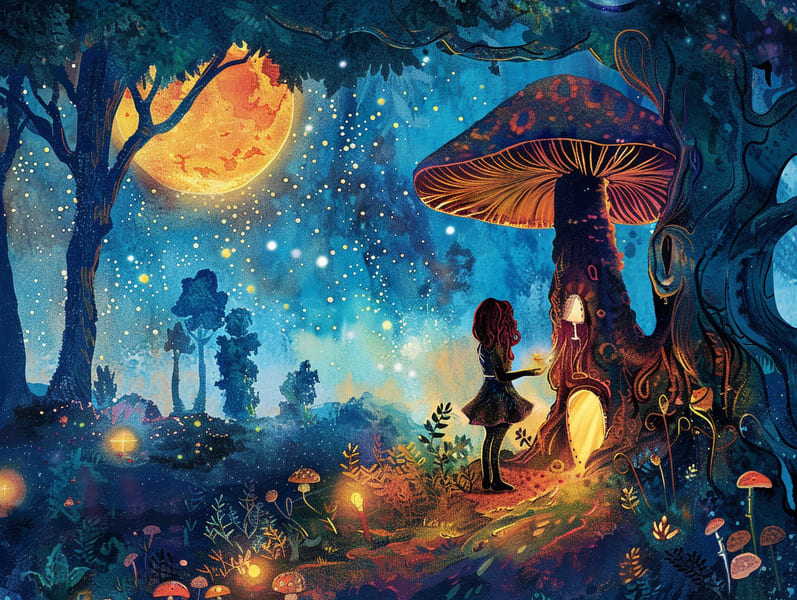
Historical fairy tales have deep roots. These tales have been passed down from one generation to the next millennia before they were ever published. They arose from a variety of societies, including European traditions. They were initially narrated among adults, often carrying themes and messages aligned with the societal norms and beliefs of the time.
The famous Grimm duo, Jacob and Wilhelm (the Grimm brothers), were among the first to compile and release many of these beloved tales. Their anthology, "Grimm's Children's Stories," included tales like "The Story of Cinderella," "The Bread Crumb Trail," and "Schneewittchen," which have since become classics in the world of children's fairy tales. Similarly, Hans Andersen's fanciful tales, such as "The Sea Maid," and "The Little Duckling," have touched hearts worldwide, securing their place in the pantheon of classic fairy tales.
Though they are old, fairy tales remain as important as ever, especially as kids' bedtime tales. These enchanting tales are now available in multiple formats, including colorful picture books, magical animations, and online fairy tales.
Their unwavering allure can be linked to several captivating elements:
Ethical Lessons: Classic fairy tales often teach important moral lessons. Tales like "The Story of the Boy Who Cried Wolf" teach the merit of integrity, while "The Story of the Tortoise and the Hare" illustrate the traits of resolve and modesty. These narratives offer the young clear distinctions between moral and immoral, forming their moral compass in a subtle yet significant way.
Compassion and Insight: Traditional fairy tales frequently depict protagonists facing obstacles and hardships, urging readers to comprehend with their struggles and celebrate their triumphs. For instance, "The Tale of Beauty and the Beast" illustrates the necessity of looking beyond appearances to appreciate the real character of a person, building kindness and perception.
Cultural Knowledge: Many old fairy tales are imbued with the cultural contexts from which they were born. Immersing in these fairy tales can provide illuminating insights into different cultures, fostering a sense of global respect and perception.
Imagination and Creativity: The imaginative elements in old fairy tales—magic wands—foster children’s creative thoughts. These fairy tales guide readers to imaginary realms, activating innovative thinking and a sense of delight that lasts a lifetime.
Classic fairy tales are not only whimsical but also instructive. They work as fantastical tools in promoting various mental and emotional abilities in young ones. When ancient fairy tales are spoken out loud, they nurture verbal skills by introducing new word meanings and sophisticated sentence structures. This practice also improves hearing abilities and focus, as the young keep up with the story, enthusiastic to see what happens next.
Furthermore, debating the themes and characters of traditional fairy tales can improve thinking get more info skills and evaluative skills. Young readers are guided to recognize patterns, foresee events, and get cause and effect. These explorations also benefit children articulate their thoughts and feelings, promoting their emotional intelligence.
In today’s cyber age, the proliferation of internet fairy tales has made these narratives more available than ever. Digital sites and online apps make available huge assortments of famous fairy tales that can be viewed or listened on anytime, anywhere. Fairy tales voiced are particularly liked, providing an engaging way for young readers to take part in these mesmerizing stories. Read-aloud books and read-out-loud stories guide characters and settings to life, often enhanced by charming harmonies and instrumentals that boost the narrative experience.
The timeless fascination of old fairy tales lies in their ability to evolve to modern days while continuing with their fundamental ideas. Contemporary reimaginings of these stories often spotlight more different figures and modern settings, making them pertinent to today’s audience. However, the essential messages of spirit, sympathy, and honesty remain unchanged, continuing to resonate with young readers of all ages.
Classic fairy tales also offer a sense of calm and knownness. They extend a tidy narrative with a definite beginning, middle, and end, often winding up with the ending of conflicts and the triumph of good over evil. This constancy can be solacing for kids, affording a sense of stability in an always shifting world.
Timeless fairy tales continue to allure and teach new generations, maintaining their wonder and meaningfulness in modern society. As children's night stories, they present a perfect blend of captivation and insight, nurturing moral values, empathy, and creativity. The presence of digital fairy tales and the favor of fairy tales spoken validate that these traditional narratives remain obtainable to new generations.
By defending and conveying these tales, we continue to revere the rich tapestry of tradition and cultural heritage. Whether you are experiencing a beautifully illustrated book, enjoying a digital collection, or listening via an read-aloud story, the grandeur of old fairy tales is always within reach. These narratives emphasize of the unfading effect of fairy tales and its ability to unite us across epochs and places.
No matter if you are seeing a richly illustrated book, viewing a web-based library, or hearing an sound book, the allure of old fairy tales is always within reach.
These tales teach us of the invariable power of storytelling and its ability to link us across eras and regions, establishing a link that charms and informs alike.
Comments on “The Beginning of Ancient Fairy Tales with the Persistent Elegance.”